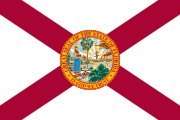Floridanos
 | |
| Total population | |
|---|---|
| unknown | |
| Regions with significant populations | |
| Languages | |
| Spanish (American Spanish, Mexican Spanish, Cuban Spanish, Dominican Spanish, Puerto Rican Spanish, Colombian Spanish, Venezuelan Spanish, Etc.), English, Spanglish (Cubonics) | |
| Religion | |
| Predominantly Roman Catholic | |
| Related ethnic groups | |
|
Floridanos (English: Floridians) is a term for colonial residents of the Spanish settlements in St. Augustine and Pensacola[1] who were born in Spanish Florida.[2] Descendants of the original Floridanos can be found throughout the state, especially in St. Augustine,[3] as well as in Miami, Tampa, and Orlando.
History[edit]
Established on September 8, 1565, St. Augustine is the oldest continuously inhabited European settlement in what is now the United States.[4] From that time on, hundreds of Spanish soldiers and their families moved from Cuba to St. Augustine to establish new lives. Following Spain's defeat in the Seven Years' War, Spain ceded Florida to Great Britain in 1763. Almost all of St. Augustine's Spanish settlers left Florida during the period that British ruled East Florida, with many of them moving to Cuba. More than 3,000 Floridanos left Florida for Havana, Cuba between 1763 and early 1764.[5] Spanish Floridians in west Florida mostly fled to Veracruz, Mexico, with about 620 sailing from Pensacola. The term "Floridano" was the term used by the Spanish colonial authorities to designate Spanish Floridian immigrants to Cuba.[6] Spain recovered East Florida and gained control of West Florida through the Peace of Paris of 1783.[7][8] The governors of the provinces of East and West Florida promoted Spanish migration to them. Florida was ceded to the United States in 1819 by the Adams–Onís Treaty.
In 2010, an historical marker titled "Los Floridanos" that commemorates the Floridanos was unveiled at St. Augustine's Visitor Information Center.[6]
Demographics[edit]
The number of descendants of Spanish settlers in Florida is unknown. However, two of the earliest settlers, Francisco Sanchez and Manuel Solana, are known to have between 500 and 1,000 descendants living in the state. Manuel Solana was a descendant of Alonso Solana who had arrived to Florida in 1613 as a soldier in the Spanish military. These settlers were some of the few Spaniards who remained in Florida when the territory was ceded to Great Britain in 1763. Their descendants founded the Los Floridanos Society in St. Augustine,[9] whose main function is to teach the history and legacy of the first settlers (1565-1763) to interested people. Some people of Cuban origin living in Florida also have ancestors in Colonial Florida. Some of the descendants of East Florida Governor José María Coppinger, who was not a settler of Florida and lived in Cuba his last years, also live in Florida.[10][11]
Notable Floridanos[edit]
- Eligio de la Puente (1724–1781), Floridano who held various public offices in St. Augustine, Florida and in Havana, Cuba during the 18th century
See also[edit]
- Spanish Florida
- Isleños
- Hispanics
- Spanish Americans
- Cuban migration to Miami
- Hispanic and Latino Americans in Florida
References[edit]
- ^ Balsera, Viviana Díaz; May, Rachel A. (2014). La Florida: Five Hundred Years of Hispanic Presence. University Press of Florida. p. 8. ISBN 978-0-8130-5505-3.
- ^ Bushnell, Amy Turner (1995). Situado and Sabana: Spain's Support System for the Presidio and Mission Provinces of Florida. University of Georgia Press. p. 17. ISBN 978-0-8203-1712-0.
- ^ James A. Jones, Jr. (2015-09-05). "Manatee's 'Los Floridanos' to attend 450th anniversary reunion in Saint Augustine". Bradenton Herald. Retrieved 2021-10-05.
- ^ Fenelon, James V. (2023). Indian, Black and Irish: Indigenous Nations, African Peoples, European Invasions, 1492-1790. Taylor & Francis. p. 126. ISBN 978-1-000-86928-6.
- ^ Landers, Jane (1996). "An Eighteenth-Century Community in Exile: The Floridanos in Cuba" (PDF). New West Indian Guide/ Nieuwe West-Indische Gids (1/2). Leiden: 41.
- ^ a b Parker, Susan R. (23 May 2010). "Identifying los floridanos was important task". St. Augustine Record.
- ^ Wright, J. Leitch (1972). "Research Opportunities in the Spanish Borderlands: West Florida, 1781–1821". Latin American Research Review. 7 (2). Latin American Studies Association: 24–34. JSTOR 2502623.
- ^ Weber, David J. (1992). The Spanish Frontier in North America. New Haven, Connecticut: Yale University Press. p. 275. ISBN 978-0-300-05917-5.
- ^ Lilly Rockwell (2013-01-05). "Early Spanish settlers saw Florida as 'a business opportunity'". Florida Trend. p. 5. Retrieved 2021-05-24.
- ^ Patricia Riles Wickman (August 27, 2006). Osceola's Legacy. University of Alabama Press. pp. 39–40. ISBN 978-0-8173-5332-2.
- ^ Francisco Xavier De Santa Cruz Y Mallen; Francisco Xavier de Santa Cruz y Mallén (conde de San Juan de Jaruco) (1988). Historia de familias cubanas. Editorial Hércules. p. 170. ISBN 978-0-89729-409-6.
